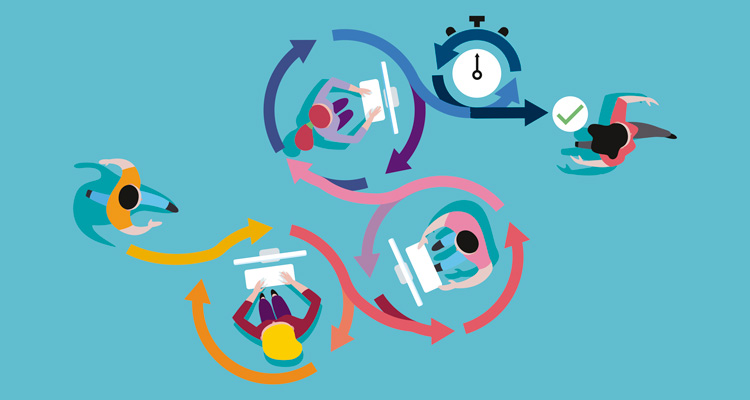
You’ve become an Agile leader, putting the systems in place to successfully scale Agile across your entire organization. The next step is to ensure teams don’t lose momentum, carrying their same energy, enthusiasm, and urgency from one project to the next. This is where enterprise Kanban software comes into play. It ensures teams work together cohesively by maximizing transparency, accountability, and communication in a company-wide workflow.
In 2016, 3,000 top Agile and Lean organizations were asked to identify the most important factor that contributed to their success. Of the respondents, 69% admitted executive sponsorship was the most helpful. And that was followed closely by consistency and the implementation of a company-wide management tool like enterprise Kanban software. From this information, we can surmise two things:
- Scaled Agile works best when supported by an executive champion.
- Enterprise Kanban software helps ensure all Agile teams are on the same page.
When you stop and think about it, both of these points make perfect sense. There’s a lot of work that goes into scaling Agile, and without the sponsorship and support from the top levels of your organization, it becomes even more difficult to challenge departments’ ideas of how management should and shouldn’t operate. On top of that, many of the ways workers and management operate simply can’t break down. At least, not without the implementation of an Agile-driven tool that increases communication and makes it easier to prioritize their dynamic, always-shifting workflow.
That’s where enterprise Kanban applies. But how exactly does this workflow management tool actually help large-scale businesses adapt to the Agile methodology?
Let’s take a look at some of the ways enterprise Kanban helps teams in a scaled Agile environment.
1. It Increases Flexibility
A workflow management tool is only as good as its flexibility. Not every project runs as smoothly as planned. Sometimes processes get held up, pushing back deadlines and causing priorities to be reassessed. Teams deal with this by being trained to expect the unexpected, and their management tools need to reflect that. If not, projects can come to a screeching halt as priorities need to be manually adjusted and teams contacted one by one.
Fortunately, enterprise Kanban prevents unexpected disruptions like the one mentioned above. Designed to be as flexible as possible, Kanban is built for change. It allows teams to plan, manage, and track their work in real-time. And when the unexpected happens, those same projects can be adjusted in real-time for everyone to see.
While important for all organizations, this level of flexibility is especially important for companies scaling Agile where goals and outcomes are constantly evolving.
2. Kanban Reduces Waste
When Kanban was first developed, it was used to help automobile manufacturers work more efficiently on the assembly line. Kanban made it easier to manage inventory and boost productivity without sacrificing quality or increasing operating costs.
These days, it’s used to help organizations outside of manufacturing reduce waste in the form of:
- Rework
- Unnecessary meetings
- Changing deadlines
- Duplicate effort
By cutting back on waste, organizations are able to cut costs and manage time more effectively. But Kanban’s benefits don’t stop there. Good resource management also removes some of the stress and pressure in the workplace by simplifying task management. That way, teams don’t become overwhelmed at the sight of a growing workflow.
3. It Provides Leaders with Deeper Insight
One of the key benefits of adopting enterprise Kanban is the transparency it brings to the workflow. If you’re an Agile leader, this makes tracking projects easier by allowing you to monitor the following metrics in real-time:
- Tasks in progress
- Assignments sitting in the work queue
- The length of time your team has been working on a project
- Any roadblocks inhibiting team members from completing their assignments on time
These are just a few of the metrics you can monitor using Kanban, and it’s all important for helping you manage teams and resources more effectively. Instead of spending time searching through spreadsheets for up-to-date project information or wasting time in status meetings, you can access all important information in your project dashboard. Not only does this save you time that could be used elsewhere, it also makes it easier to stay current with any changes with resources or your workflow.
Plus, it keeps your team updated as well. That way, everyone can make informed decisions regarding ongoing projects.
4. It Adds Accountability and Limits Dependencies
As we previously mentioned, Kanban makes it easier to track the status of projects in real-time. This, in turn, creates more accountability in an Agile organization, where managers are constantly looking for ways to improve speed and value.
For workers getting used to scaled Agile, the thought of more accountability can be intimidating at first. But over time, most employees end up working well under Kanban’s transparency. Accountability creates a sense of ownership, encouraging teams to look at ways to increase value and productivity. Team members start using Kanban to communicate more about projects, where they solve problems and discuss ways work should be executed. This reduces dependencies, empowering employees to overcome obstacles and work independently when needed.
5. It Drives Continuous Improvement
Most workflow management systems exist with one goal in mind: helping teams manage work. Enterprise Kanban goes beyond that, giving managers the tools needed to find and solve problems that inhibit productivity. Kanban can be used to identify inefficiencies and solve them using work-in-progress limits, blocked cards, and the many other project management tools Kanban has to offer. From there, team members can create cards dedicated to solving these problems and preventing similar setbacks from occurring in the future.
Of course, that’s not to say that Kanban doesn’t also make workflow management easier, because it does. But Kanban is designed for flexibility, and part of that flexibility is being able to identify and correct inefficiencies. This creates a culture of continuous improvement, which is an essential part of the Agile approach.
Facilitating Your Agile Transformation Through Enterprise Kanban
We’ve spent a lot of time focusing on Agile transformation at the macro-level. And yes, good leadership is a prerequisite for delivering Agile across an entire organization. But that’s only a part of the scaling process. Agile needs to be custom tailored to meet the needs of the team it’s supporting, and this requires participation and feedback across all levels within an organization. Enterprise Kanban allows for that, giving managers, team leaders, and employees a platform to share ideas and discuss workflow management techniques that support Agile innovation within their department. That way, teams can start working faster and more effectively, striving towards continuous improvement and delivery.
Want to learn more about enterprise Kanban and how it can be used to drive innovation and continuous improvement within your organization? Take a look at our eBook on enterprise Kanban for scaling Agile teams. There, you’ll learn more about the steps your organization needs to take in order to deliver company-wide agility.





